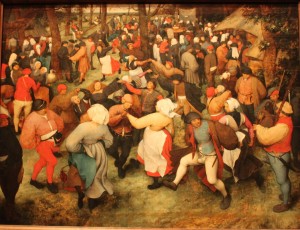In the New York Times yesterday, economist Robert H. Frank attempts to apply a cost-benefit analysis to one of the most iconic works in the collection of the Detroit Institute of Arts, The Wedding Dance by Pieter Bruegel the Elder. He thinks it would be great idea to sell it. But this approach is wrong — in its facts, in its methods, and in its conclusions.
Frank, who is an economics professor at the Johnson Graduate School of Management at Cornell University, writes that “the prices fetched by famous artists have spiked sharply in recent decades” and adds that “relative to famous art, lesser-known works have become much cheaper in recent years,” which leads him to suggest that “curators…invest more heavily in emerging artists.” I’m not sure how Frank defines “famous” or “lesser-known,” but the spiking art prices over the last two decades are for contemporary artworks, not Old Masters like Bruegel. If anything, Old Masters (while not appearing on the market very much) have grown more affordable, in relative terms, while contemporary art prices have skyrocketed. But, most importantly, Frank’s price-oriented thinking is overlooking the fact that the DIA’s mission is not to collect emerging art, but to preserve and enrich a collection that spans several countries and centuries.
Frank’s numbers don’t make sense in the real world. Writing that Christie’s estimates that The Wedding Dance could fetch up to $200 million, he applies a 6% interest rate and concludes that “the forgone interest on that amount would be approximately $12 million a year.” Christie’s actually estimated the fair market value to be between $100 and $200 million, but as long as you’re an economist building castles in Spain, you may as well take the highest number possible. In any case, the amount of hypothetical principal is irrelevant, because if the painting were sold the profits would not be sitting in Detroit’s coffers earning interest. They would be handed over to the banks who are the bankrupt city’s creditors.
Basically, Frank is pretending that the DIA is an imaginary case study in an economics 101 textbook: “One way to think about the decision is to imagine Detroit as a new municipality about to build a museum stocked and operated at taxpayer expense. Which paintings should it display?” But the DIA is not operated by the city of Detroit. It’s an independent non-profit institution whose finances (unlike those of the city of Detroit) are entirely in order. As I wrote in a recent article for Le Journal des Arts, the taxpayers who support the museum are those of Wayne county (where Detroit is located) and the two neighboring counties. This millage was approved by voters in 2012, and their tax dollars provide $24 million of the museum’s $31 million annual operating costs. The residents of Macomb and Oakland counties, who enjoy free admission to the museum, would not accept its being raided to pay Detroit’s debts. As museum director Graham W.J. Beal has explained, selling works from the collection would betray voters’ trust, lead to the revocation of the millage, and make the institution insolvent. Selling even one painting from the collection would have real repercussions, and may not even be legal; Michigan’s attorney general, Bill Schuette, declared that any sale would be illegal, stating that, although owned by the city, the artworks are held in trust for the people of the state of Michigan.
Economists are usually thought of as pragmatists, but all too often they’re eager to toss out the facts and the context in order to play around with numbers. They like numbers. Numbers will say whatever you want them to.
Homepage image © Kate Deimling, middle image Pieter Bruegel the Elder, “The Wedding Dance,” via Wikimedia Commons.


